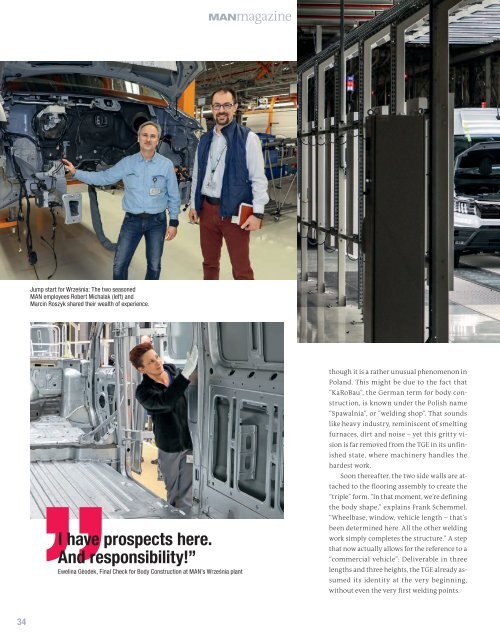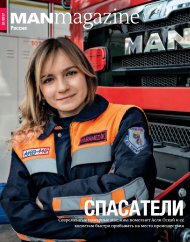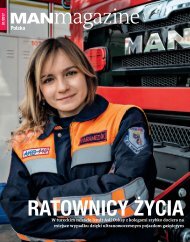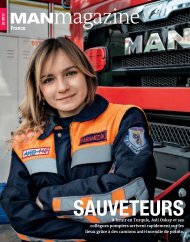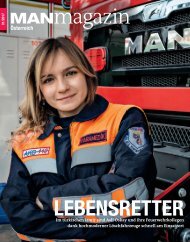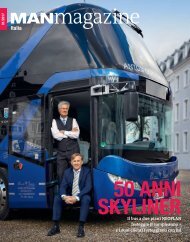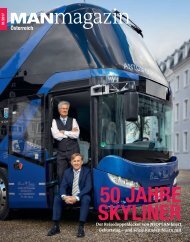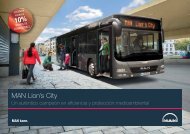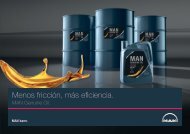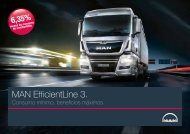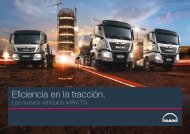MANmagazine Truck edition 1/2017 Great Britain
In this issue of MANmagazine, we introduce the many different areas in which our family of trucks can be used to meet a wide range of customer requirements. We accompany a TGM on a fire-fighting exercise in Izmir, take fuel to filling stations in Indonesia in a TGS, deliver "white goods" in a TGL and transport valuable sports cars to race tracks in a TGX. We also visit the high-tech Polish plant in Września on your behalf where MAN TGE vans are made. You can also read about how the RIO platform can open up new opportunities for the transport industry and why you can get way ahead with a long truck.
In this issue of MANmagazine, we introduce the many different areas in which our family of trucks can be used to meet a wide range of customer requirements. We accompany a TGM on a fire-fighting exercise in Izmir, take fuel to filling stations in Indonesia in a TGS, deliver "white goods" in a TGL and transport valuable sports cars to race tracks in a TGX. We also visit the high-tech Polish plant in Września on your behalf where MAN TGE vans are made. You can also read about how the RIO platform can open up new opportunities for the transport industry and why you can get way ahead with a long truck.
Create successful ePaper yourself
Turn your PDF publications into a flip-book with our unique Google optimized e-Paper software.
01/<strong>2017</strong><br />
asked whether she feels at home here, she answers<br />
with a widely smiled “Tak!” Her expression<br />
certainly goes beyond a simple “yeah”.<br />
It isn’t just the “spring chickens” who feel<br />
fine in this TGE production plant. True MAN<br />
veterans such as Robert Michalak and Marcin<br />
Roszyk, who have been employed at MAN<br />
since 2001 and 1998 respectively, also enjoy<br />
working on an entirely new vehicle with the<br />
characteristic lion on the front. “It’s really nice<br />
to see our old and familiar logo,” admits<br />
Marcin. “We used to build buses, and now we<br />
build the TGE. They’re all part of the same<br />
family, aren’t they?” The two were part of<br />
Września from the get-go and, like many others,<br />
lent their wealth of experience to the<br />
plant. A good example of this is “horizontal assembly”,<br />
where the new TGEs are lined up in a<br />
row like cartridges in a belt, which facilitates<br />
the assembly of bulky parts such as the roof<br />
liner and the inner panelling. “If the vehicles<br />
Jump start for Września: The two seasoned<br />
MAN employees Robert Michalak (left) and<br />
Marcin Roszyk shared their wealth of experience.<br />
Glossy product of many industrious hands:<br />
The Września plant creates about 3,000 jobs.<br />
came one after another along the assembly<br />
line, there would hardly be enough space to<br />
manoeuvre these components into the loading<br />
space. This way, however, it’s not a problem,”<br />
explains Marcin. Once again, experience,<br />
and the capacity to think outside the<br />
box, proves tremendously useful.<br />
„I have prospects here.<br />
And responsibility!”<br />
Ewelina Gèodek, Final Check for Body Construction at MAN’s Września plant<br />
though it is a rather unusual phenomenon in<br />
Poland. This might be due to the fact that<br />
“KaRoBau”, the German term for body construction,<br />
is known under the Polish name<br />
“Spawalnia”, or “welding shop”. That sounds<br />
like heavy industry, reminiscent of smelting<br />
furnaces, dirt and noise – yet this gritty vision<br />
is far removed from the TGE in its unfinished<br />
state, where machinery handles the<br />
hardest work.<br />
Soon thereafter, the two side walls are attached<br />
to the flooring assembly to create the<br />
“triple” form. “In that moment, we’re defining<br />
the body shape,” explains Frank Schemmel.<br />
“Wheelbase, window, vehicle length – that’s<br />
been determined here. All the other welding<br />
work simply completes the structure.” A step<br />
that now actually allows for the reference to a<br />
“commercial vehicle”: Deliverable in three<br />
lengths and three heights, the TGE already assumed<br />
its identity at the very beginning,<br />
without even the very first welding points.<br />
© MAN <strong>Truck</strong> & Bus<br />
3,000<br />
individual<br />
components<br />
are installed in the MAN TGE. Each part<br />
must meet the high quality standards of<br />
the Września plant.<br />
Quite a while later, when the body glides<br />
toward completion, Ewelina Gèodek uses her<br />
eyes and hands to check whether all of the<br />
welding points are positioned correctly. She<br />
has been working at the plant since 2016 and<br />
was drawn there mainly because of the advancement<br />
opportunities. “I have prospects<br />
here,” she says with pleasure. “And I have responsibility!”<br />
Observing her while working,<br />
clearly affirms her statement. Always conducted<br />
by a team of three, a close inspection<br />
investigates the TGE body for around three<br />
minutes. Professional routine now prevails<br />
and the team works quickly through all the<br />
areas. Upon team consultation, it is Ewelina<br />
who gives the final approval for the body,<br />
which only then may move on to the paint<br />
shop. Perhaps the harmonious working climate<br />
that is so tangible in this plant becomes<br />
especially prevalent here: People rely on each<br />
other, respect each other – and it is indeed<br />
apparent that Ewelina enjoys her job. When<br />
YOUNG PEOPLE such as Piotr Gréskowiak<br />
can in turn learn from the “old hands”. At<br />
merely 19, Piotr installs cockpits. This is his<br />
very first job and he’s proud of it, particularly<br />
because he comes from Września himself. “In<br />
my family, we talk a lot about the plant and<br />
how much it drives the city and the region forward.”<br />
Assisted by a robotic arm controlled by<br />
a joystick, he pushes the next instrument panel<br />
into the TGE’s interior. It will be positioned<br />
with millimetre precision, while his colleague<br />
installs the corresponding cabling up front in<br />
the engine compartment – within three minutes<br />
and 25 seconds, everything is screwed<br />
into place. No matter how routine the hand<br />
movements are for Piotr, they are extremely<br />
important to him, as he still lives at home.<br />
“My work here is also a step towards my independence.<br />
And I enjoy it,” he says with a shy<br />
smile. The TGE standing in the background<br />
also began with small metal pieces. Now that’s<br />
what might be called development potential …<br />
34<br />
35


